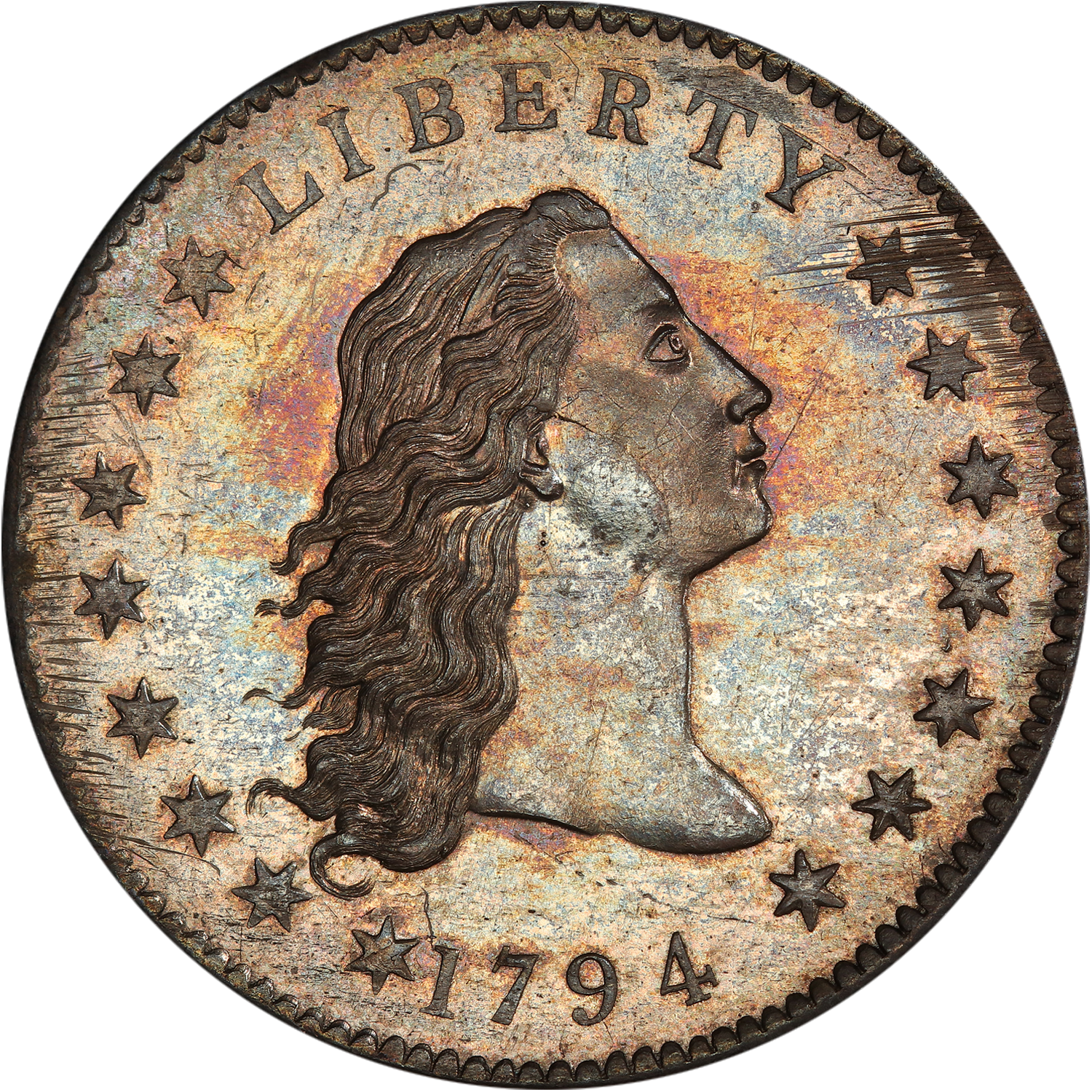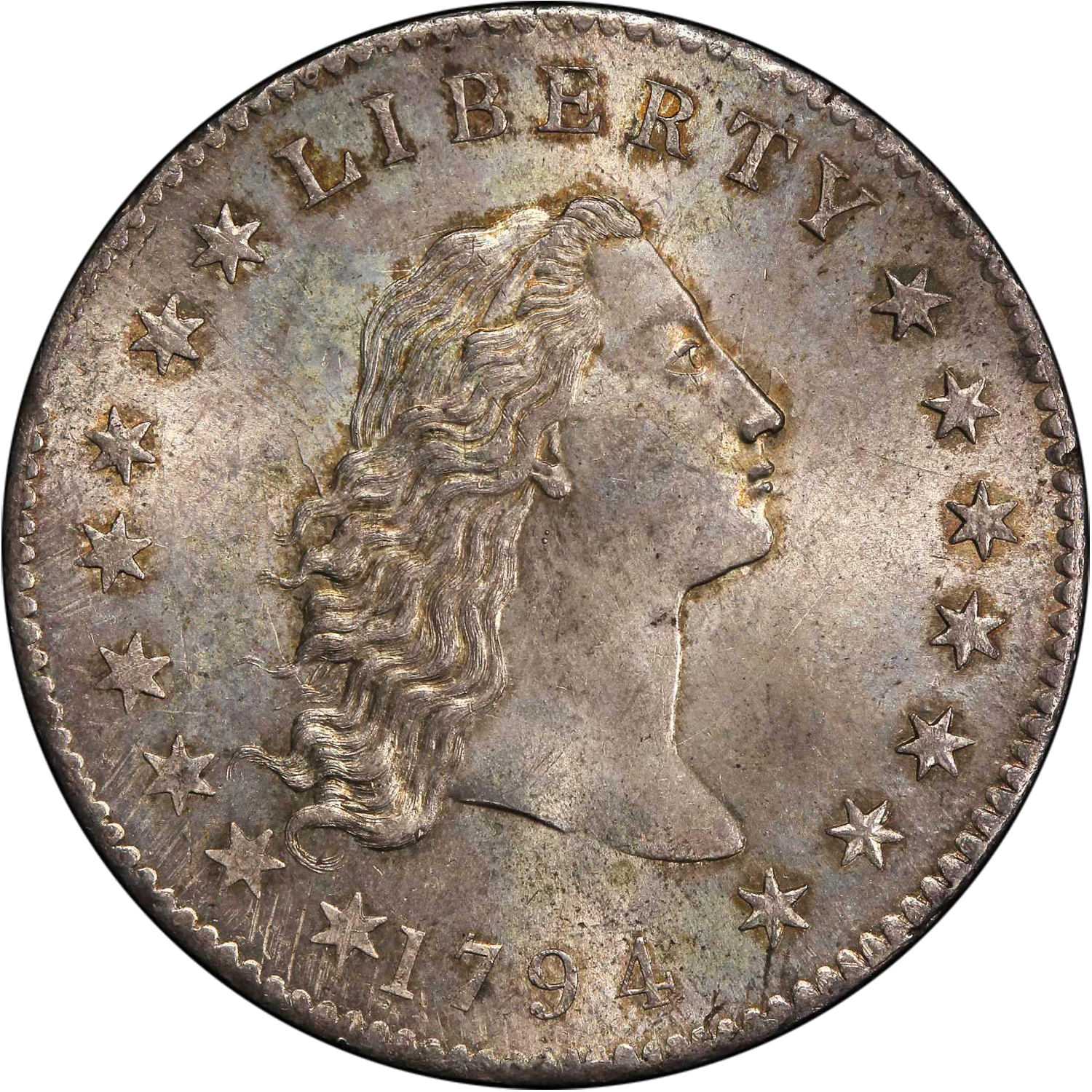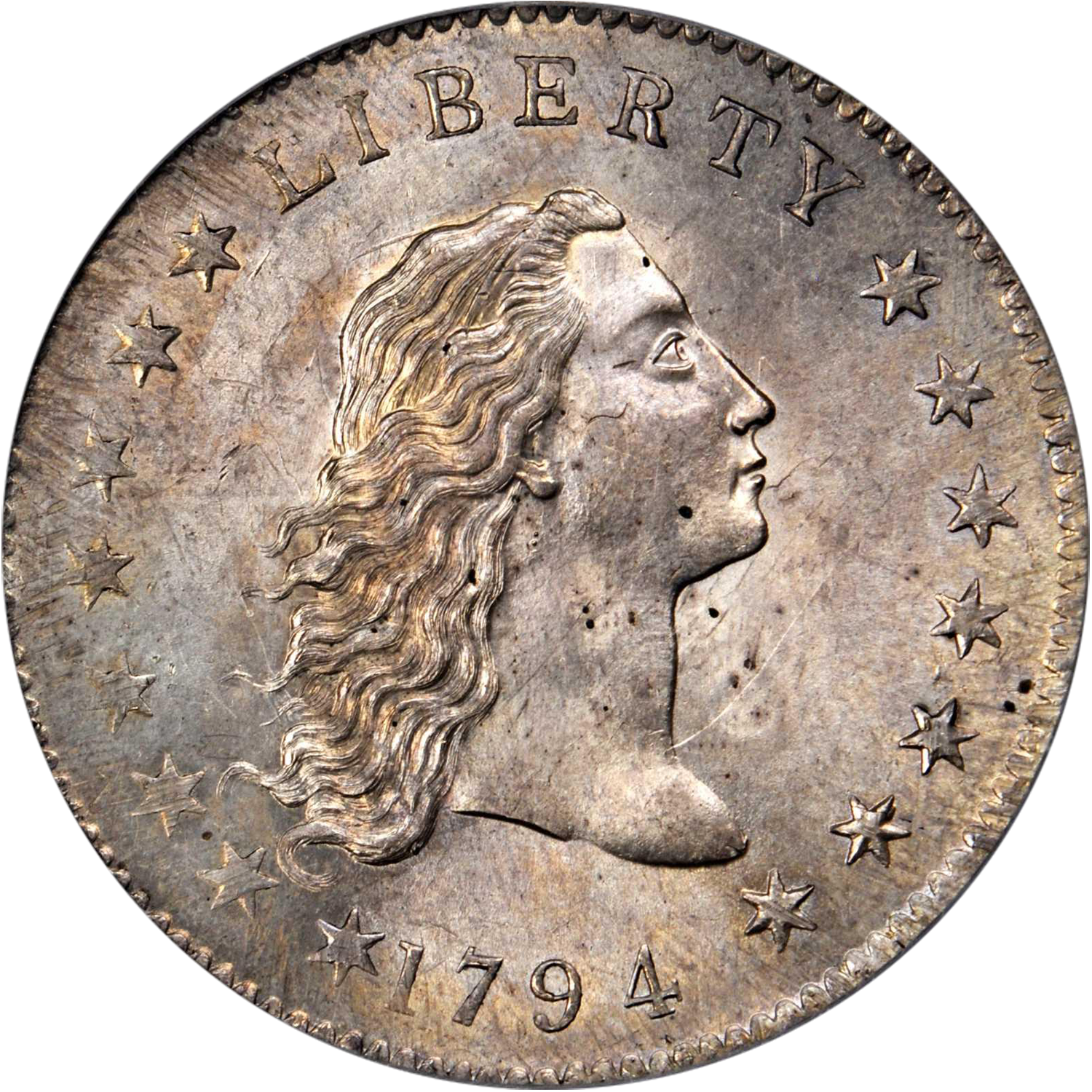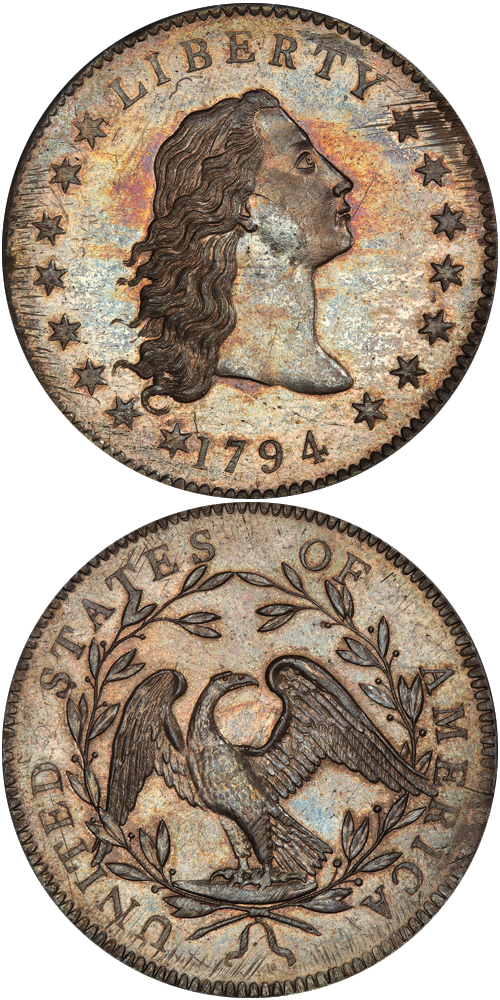1794 Flowing Hair Dollar
The Silver Dollar was authorized by the Act of April 2, 1792 that also established the United States Mint and created our nation’s coinage. While not the highest-denomination coin authorized by that act, the Silver Dollar was obviously the most important as it was the standard unit upon which the United States’ monetary system would be based. All other coins struck in the United States Mint from the 1790s to the present day are either fractional parts of the Dollar or multiples of that unit. For this reason more than any other, the Silver Dollar has long held a place of honor in the pantheon of American numismatic rarities. It is without a doubt the most popular and widely collected coin ever struck in the United States Mint, and is eagerly sought by both advanced numismatists and the general public as a historic treasure, a cherished collectible and (for common-date examples of the later Morgan and Peace types) a storehouse of wealth for those with an interest in owning silver bullion.
The most important Silver Dollar ever struck—and also one of the rarest—is the 1794 Flowing Hair. The first coin of its kind and a major numismatic rarity in all grades with a net mintage of just 1,758 pieces, the 1794 Flowing Hair Silver Dollar is a coin of which legends are made. Survivors are always greeted with eager anticipation when they are offered for sale either through auction or via private treaty. And as a further indication of the importance and popularity of the issue, the 1794 Flowing Hair Dollar has been honored with the #20 ranking in the widely distributed book 100 Greatest U.S. Coins by Jeff Garrett and Ron Guth (2003 edition consulted).
The design of the nation’s first Silver Dollar was entrusted to Chief Engraver Robert Scot, whose obverse features the most mature evolution of the Flowing Hair Liberty portrait that was first featured on Joseph’s Wright’s Libertas Americana Medal of 1783. By the time Wright’s Liberty found her way onto the Silver Dollar, however, she had been turned to the right and was displayed sans the liberty pole and cap. The basic design is superficially similar to its earliest inception, nonetheless, with Liberty’s hair free flowing along the back of her head and neck, thus explaining the widely used Flowing Hair name for coins of this type. Scot’s Dollar obverse received 15 stars arranged at the border eight left, seven right in honor of the number of states that made up the Union in 1794, as well as the word LIBERTY at the upper border and the date at the lower. The reverse of the Flowing Hair Silver Dollar mirrors Scot’s work for the Flowing Hair Half Dime and Half Dollar, examples of which were also struck for the first time in 1794. A spread-wing eagle is surrounded by two branches bound at their base by a thin ribbon with the legend UNITED STATED OF AMERICA around the border.
Curiously, the denomination is not featured on either the obverse or reverse of the Flowing Hair Silver Dollar—something that might appear as a sign of ineptitude on the part of early Mint employees to someone familiar with United States coinage of the 21st century. The omission was intentional, however, as United States coinage was new to the world market of the 18th century and the term “Dollar” would have been unfamiliar to merchants of the day. In order to facilitate the coins’ acceptance in as many quarters as possible, therefore, the Mint omitted the denomination from the design and opted to let the Silver Dollar’s weight and precious metal content establish its value. For those willing to look closer, nonetheless, they would find the denomination on the edge, which for Flowing Hair Silver Dollars is lettered HUNDRED CENTS ONE DOLLAR OR UNIT with decorations between the words. By the time Mint employees had posted the necessary bonds to begin working with precious metals—which was not until 1794 even though the Silver Dollar had been authorized by Congress in 1792—Mint Director David Rittenhouse wanted to begin production of these coins as soon as possible. The necessary bullion was lacking, however, as the early United States Mint was dependent upon private deposits of silver and gold and did not strike such coins on government account. Accordingly, Rittenhouse deposited $2,001.34 worth of his own silver on August 29, 1794 so that Dollar production could begin.
And begin it did, the Mint using Rittenhouse’s bullion and a single set of dies to strike 2,000 Silver Dollars. Almost immediately, 242 of those coins were found to be totally unacceptable as to weight and/or striking quality and were either remelted or subsequently used as planchets for 1795-dated Silver Dollars. The deduction of the rejected coins leaves a net mintage of just 1,758 pieces for the 1794 Silver Dollar, all of which were delivered to Mint Director Rittenhouse on October 15, 1794. As Rittenhouse had deposited the bullion for these coins, it then fell to him to further distribute the pieces. Even those 1794 Dollars that were deemed acceptable for distribution evidence many of the difficulties with coinage operations suffered by the early United States Mint. Virtually all of the known examples are softly struck to one degree or another at the left-obverse and -reverse borders. This is due to the Mint’s use of a press that was initially intended for smaller-size coins, as well as the fact that the dies eventually “slipped” and became misaligned in the press. On some 1794 Dollars the misalignment is so pronounced that the date can be difficult to discern. Additionally, many 1794 Dollars display adjustment marks that represent the Mint’s filing down of overweight planchets to make them confirm to the legally specified weight range for this issue. While these adjustment marks are often innocuous, they are sometimes so numerous as to severely compromise one or more elements of a coin’s design.
Regardless of striking quality or level of preservation, a 1794 Flowing Hair Silver Dollar is an extremely important find in numismatic circles, and the ownership of even a low-grade and/or impaired example is the mark of an important collection. Writing in the 2010 edition of the reference The Flowing Hair Silver Dollars of 1794: An Historical and Population Census Study, Martin Logies of the Cardinal Collection Education Foundation accounts for a surviving population of only 134 distinct examples. Many of those coins are significantly impaired due to cleaning, repairs, edge damage, etc. Obviously, the historical significance and rarity of the nation’s first Silver Dollar led to the preservation of many examples during the 19th century that, due to their poor state of preservation, would probably have been melted for their bullion content had they been examples of more common issues such as the 1795 Flowing Hair or 1799 Draped Bust Silver Dollars. Even most problem-free 1794 Flowing Hair Dollars that have survived did so only after acquiring some degree of wear. (The August 2017 ANA Auction. Ended: August 8th, 2017, lot 2113)
David Rittenhouse and His 1794 Dollars
David Rittenhouse, a renowned man of science who served as the first director of the Mint, is usually depicted as reserved. His friend Thomas Jefferson praised his "genius, science, modesty, purity of morals, [and] simplicity of manners" when it came time to follow him as president of the American Philosophical Society. As true as all these compliments might have been, Rittenhouse was also a fairly savvy political operator, and he clearly sought to make a splash when the Mint began striking its first coins from precious metals. Entrusted with sole control over the United States Mint by George Washington, with the surety bonds posted for the chief coiner and assayer after much delay (and an Act of Congress to reduce them, passed on March 3, 1794), he could have started precious metal coinage production with diminutive half dimes, echoing the "small beginnings" of a national coinage began at another facility in 1792. Dimes, quarters, or half dollars would have been better suited for the somewhat undersized press he had at hand on October 15, 1794. Rittenhouse instead made a conscious decision that the first specie struck at the United States Mint would be dollars, the basic unit of our national currency and the largest coins struck in the United States in the 18th century.
The first deposit of silver to arrive at the United States Mint came from the Bank of Maryland on July 18, 1794. Composed of French coins, Assayer Albion Cox's tests of the metal’s fineness averaged just .737 fine, meaning the deposit would have to be heavily refined to bring it up to the congressionally mandated .8924 standard. With the refining department understaffed, Rittenhouse made a bold choice: rather than follow the letter of the law, whereby depositors receive their finished coins based upon the order of their initial deposits, Rittenhouse himself jumped the line. On August 29, 1794, he made two deposits, composed of silver ingots of relatively fine purity (.900 and .8665 fine). They added up to $2001.33 worth of silver, or enough to strike almost exactly 2,000 silver dollars.
On October 15, 1794, Chief Coiner Henry Voigt delivered 1,758 dollar coins to David Rittenhouse, representing the entire mintage for the year 1794. The Mint's workmen could have struck the entire mintage in an afternoon, using a press ill-suited for the rigors of striking the large diameter dies. Rittenhouse later received $242.50 in half dollars, plus six half dimes, to complete the total initial deposit, but numismatists have wondered for years: was the original mintage of 1794 dollars a nice round 2,000? At least one poorly struck 1794 dollar became the planchet for a 1795 dollar. Since that coin's discovery in the early 1960s, no others have been found. If more dollars were coined, they were likely so poorly struck that no fate beyond the melting pot awaited them. Of course, they may never have been struck at all, and a failure of the press could have ended the day’s work prematurely. Despite the enormity of the event, no details were recorded, and no ceremony was held.
Few comments on the new dollars were made at the time. In the December 1862 issue of The Historical Magazine, correspondent (and pioneering numismatist) Jeremiah Colburn submitted a paragraph he discovered in the New Hampshire Gazette, published in Portsmouth, New Hampshire on December 2, 1794, noting, "collectors of American coins are aware of the rarity, and the difficulty experienced, in obtaining fine specimens of this date." It read:
"Some of the Dollars now coining at the mint of the United States have found their way to this town. A correspondent put one into the Editor's hands yesterday. Its weight is equal to that of a Spanish dollar, but the metal appears finer. One side bears a head, with flowing tresses, encircled by fifteen stars, and has the word 'liberty' at the top, and the date, 1794, at the bottom. On the reverse is the bald eagle, enclosed in an olive branch, round which are the words 'United States of America.' The edge is well indented, in which are the words 'One Dollar, or Unit, Hundred Cents.' The tout ensemble has a pleasing effect to a connoisseur; but the touches of the graver are too delicate, and there is a want of that boldness of execution which is necessary to durability and currency."
The paragraph was published again in the American Journal of Numismatics in October, 1885 and has reappeared in various texts into modern times, though the 1862 publication appears to have been its first in a numismatic context.
Of the 1,758 dollars delivered on October 15, 1794, about 135 to 150 pieces are thought to survive, a high percentage based upon most statistical survivorship models of early American coins. This high percentage reflects the early date at which collectors placed a premium on 1794 dollars, thus saving low grade specimens that would have been consigned to the melting pot if they were of any other date. It also hints at the significance David Rittenhouse and his acquaintances must have placed upon these first United States dollars, many of whom are thought to have saved specimens. Several survive in Mint State grades; six show up on the PCGS Population Report graded MS-60 or finer.
The example to the left was sold by Stack's Bowers Galleries in the January 2013 Americana Auction, where it realized $10,016,875.
1794 Flowing Hair Dollar Auction Highlights
 PCGS SP-66, CAC Sold for $10,016,875 View Lot 13094 |  PCGS MS-66+ Sold for $4,993,750 View Lot 2041 |  PCGS MS-64, CAC Sold for $2,820,000 View Lot 2113 |






